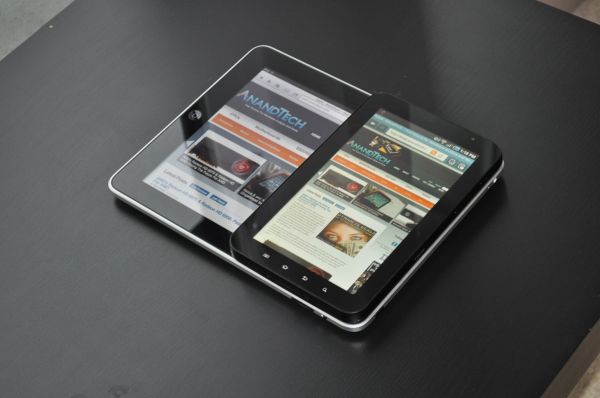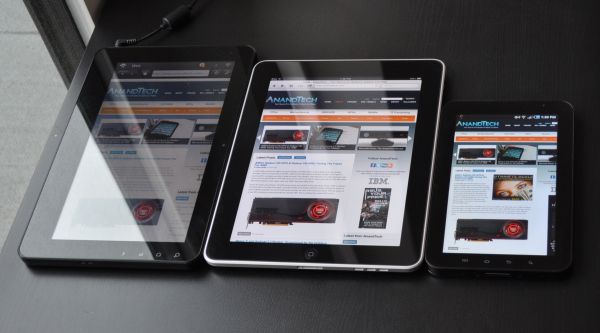Samsung Galaxy Tab - The AnandTech Review
by Vivek Gowri on December 23, 2010 9:48 AM ESTSamsung Galaxy Tab - Size Really Does Matter
The Galaxy Tab is almost exactly half the size of the iPad.
So the Galaxy Tab, as one of the first 7” tablets to release, brings up a new concern in the tablet space - how much does screen size change things? This is the first real 7” tablet I’ve played with for any length of time, but my first reaction when I pulled the Galaxy Tab out of the box was “dang, this thing is a lot smaller than I expected”. It’s literally half the size of the 9.7” iPad, dimensionally. It’s interesting to see two supposedly competitive devices have such different form factors, completely at odds with how the notebook market works.
The sizing thing is going to be a big deal for tablets going forward, and I think eventually we’ll see the market split into two or three segments based on size. It looks like some companies are already choosing one camp or the other; Apple appears staunchly in the 10” camp after Steve Jobs ripped on the entire 7” form factor, RIM is going 7” for its PlayBook, Dell started with 5” and are adding 7” and 9” models, HP took the middle road with its 8.9” slate, Samsung is adding a 10” Galaxy Tab early next year. So we’re going to be seeing tons of both 7” and 10” form factors on the market.
So why choose one form factor over the other? They’ll likely have similar internal hardware and the same WSVGA resolution on differently sized screens, so it won’t be on specs, and based on the current device pricing, I don’t expect that to be terribly different either. So, really, it comes down to whichever suits your use cases better.
Three tablets, three screen sizes. Pick your form factor wisely.
Honestly, here’s what I found: it’s more comfortable to use the 7” tablet in portrait mode, whereas it’s easier to use the 10”ers in landscape. This is true for both the 4:3 iPad or any of the 16:9 10” widescreen tablets. Part of it is in the keyboard - the 7” portrait keyboard is just comfortable enough to use with two thumbs, whereas in landscape its a bit too wide. The 10” has the opposite problem - too wide for two thumbs and too narrow for normal typing in portrait mode, but just about perfect with two handed typing in landscape. The difference is that with the 7” tablet, you can use it like a large smartphone, whereas the 10” tablets are more suited for use on a desk or table. The iPad and other 10” tablets are better as standalone netbook replacements, while the 7” Galaxy Tab almost feel like a device that’s meant to be carried in addition to a notebook.












97 Comments
View All Comments
thartist - Thursday, December 23, 2010 - link
seriously? we're gonna bring all that FAIL thing to Anandtech? go elsewhere.JohnCarney - Thursday, December 23, 2010 - link
Really? How did you do that?http://www.amazon.com/Tron-Blu-ray/dp/B001AQT15I/r...
therealnickdanger - Thursday, December 23, 2010 - link
The Tron Blu-ray was delayed by Disney due to fears that their target Tron Legacy audience would see it and laugh at the bad old CGI and then not want to see the new one.The HD master of Tron used to create the Blu-ray has been aired on HDNet and other HD channels. So while it isn't technically a Blu-ray rip, it is most definitely HD. If you didn't have the luxury of seeing it broadcast, there are a couple torrents out there if you feel so inclined.
MeanBruce - Thursday, December 23, 2010 - link
So Cool, I love Tron, thanks for giving us the info! 1982 Jeff Bridges. Are you the User?Aloonatic - Thursday, December 23, 2010 - link
I was just thinking, as these tablets are often little more than bigger versions of what many of us have in our pockets already......How hard would it be for a company to make a large touch-screen device with a big battery that one could simply slip their smart-phone into and use that way? Probably requiring something in the phones OS to recognise that it is plugged into such a device, allow it to display at a higher resolution and maybe even change it's processor/GPU power/performance profile, as it could be plugged in somewhere, or at least know that it has a larger battery power supply at hand?
Just a thought.
kmmatney - Thursday, December 23, 2010 - link
Damn good idea. I'd love to be able to pop my phone into a device to give it a larger screen, especially when just browsing on the couch. However the cost to build something like that probably isn't that much more than just making a whole new device.VivekGowri - Thursday, December 23, 2010 - link
The original Palm Foleo waves hello. I dunno if that type of thing would be any better now with the updated technologies, but the Foleo crashed and burned so badly that I think people are scared to even try.baba264 - Thursday, December 23, 2010 - link
To be honest, 6 month after the ipad launch, I still have a hard time figuring out what it is exactly that's pulling people to the tablet market.I honestly don't see much use for these tablets except as a very occasional gadget with a terribly high price tag. Or alternatively as a fashion statement, but being on a hardware site I don't think that should really apply to us.
Guspaz - Thursday, December 23, 2010 - link
There are a few things I can see people using an iPad (or equivalent device) for, but the general gist of it is that you take a smartphone's easy usability and portability, but use a larger screen to address some of the shortcomings or limitations of a smartphone. For example, browsing with touch controls can be pretty intuitive, but a smartphone's screen is small enough that it's a compromised experience. Give it a 10" screen, however, and you can get that same user experience with a device that can actually display a full website like a PC would. Or take the case of portable video playback. It's convenient to be able to watch a movie or TV shows on a smartphone, but a 3.5" screen is kind of tiny. But make it a 10" screen, and it's a completely different experience.Most other use cases are similar. Take something that was intuitive on a smartphone but had the experience compromised by the small screen (or was missing features due to it), and a tablet can solve that. E-mail works nicely on a smartphone, but the small screen means there isn't room to get both the E-mail message and the inbox open at the same time; a tablet enables that.
So you sacrifice some portability (although tablets are still more portable than a netbook or notebook), and get a lot more usability. As for price, tablets have prices on par (or lower than) with smartphones; it's hard to argue that they're expensive or overpriced without saying the same of smartphones.
mrd0 - Thursday, December 23, 2010 - link
You can use a tablet to do much more than browse the web. Our law firm, and many, many others, are starting to move to the iPad instead of laptops because they are such much more friendly in the court room and on the move. I can actually write a brief and submit it, whereas, that is nearly impossible on a smart phone...certainly painful. I don't need a full computer most of the time, so the iPad, or another 10" tablet, is ideal. It's so useful that some large firms are starting to give every associate a new iPad.Now we just need a great 10" android tablet to get away from all of Apple''s limitations/restrictions.